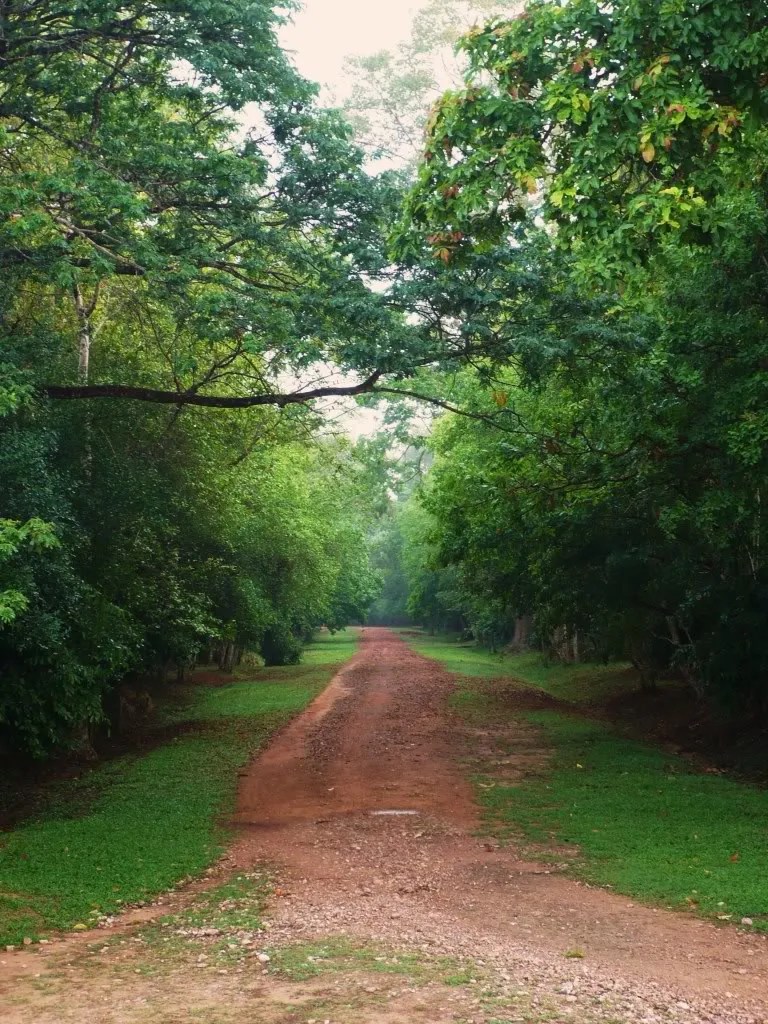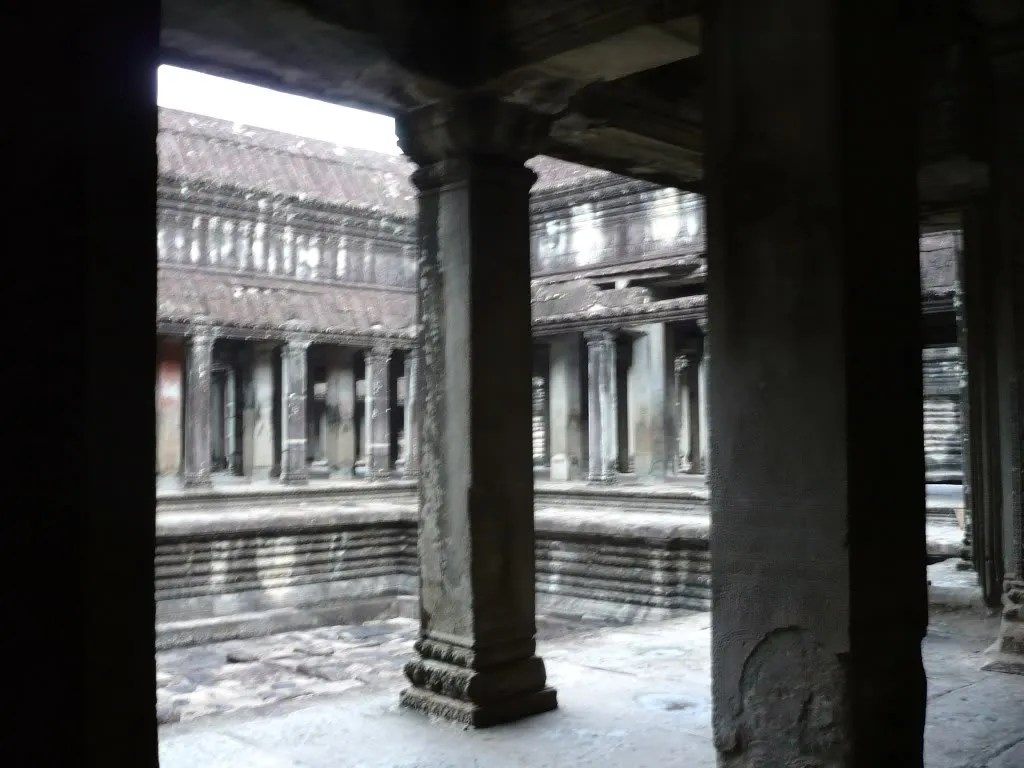Siem Reap, Cambodia
April 25, 2008
I found myself alone in cloistered hallways. Only whispering zephyrs were within earshot. The moment conjured up the centuries past. In the silent, stone-dead here and now, I sat still on ancient landings, imagining what it must have been like 900 years ago. This gallery must have echoed the pitter-patter of scurrying monks. This courtyard must have seen bare-breasted women dancing as apsara or performing rituals as devata. This terrace must have borne the pomp and power of King Suryavarman II himself, the builder of Angkor Wat.
My Angkorian adventure, however, was fraught with uninformed decisions and bad judgment. First off, I failed to consider its overwhelming size. Angkor Wat was not just one temple, but one of 50 or so major ones in the sprawling Angkor Archaeological Park, a UNESCO World Heritage Site, some 400 square kilometers in area, more than twice the size of my hometown, Quezon City! Angkor Wat, after all, meant “temple city.”
Alas, I bought a one-day pass for $20, but a three-day pass for $40 would have been recommended for culture vultures like me. A seven-day pass for $60 was for hardcore temple enthusiasts. Without a guide or a plan, I was no better than a blind mouse navigating its way through a maze – an amazing one at that. I did not know where to see what and how.
Blind mouse or enlightened traveler, I would never forget the visual tour de force of Angkor Wat. Gazing at the majestic edifice was akin to looking at a larger-than-life photograph. The sight was all the more awe-inspiring when I learned it was built nearly a millennium ago while Europe was still in the clutches of the Dark Ages.

That should not have come as a surprise because Angkor Wat was designed as an earthly representation of the universe. A microcosm of the cosmos, as it were. Perhaps it was the ancient Khmers’ way of making sense of the universe and creating order amidst natural and political chaos. Hindu in origin, the wat was converted into a Buddhist temple centuries later by succeeding rulers. I saw at least two Buddha images, but missed the statue of Vishnu to whom this temple was dedicated!
It would have been a flagrant mistake to think of Angkor Wat as merely a colossal temple. It was, in fact, a temple-mountain, and should be seen and appreciated as such. The structure symbolized the five peaks of Meru, a cosmic mountain in Hindu mythology.
Each tower, shaped like an erect lotus, was positioned in such a way that only from certain angles were all five visible. Approaching Angkor from the front, I saw only three towers forming a silhouette against the morning sky. As I made it to the back, I was surprised there were two other towers I had completely missed.

A pair of ruined structures, called the Library of Nine Planets, flanked the entry causeway as did naga balustrades, stone carvings of a serpent said to be the progenitor of the Khmer race. The entire temple area was surrounded by lush rainforest that was conspicuously absent in the road trip I just had taken through Cambodia.


The interior of the temple-mountain was a maze. This wide-eyed blind mouse was lost in amazement, not knowing which dark hallway led to which gallery. Angkor Wat, being three-tiered, shared the form of a pyramid or ziggurat with each tier smaller than the one below it.
The walls were carved with intricate bas-relief that required an eye for detail and, at least, some working knowledge of Hindu traditional stories, such as the Ramayana and The Churning of the Ocean of Milk. The carved images read like a scroll that unraveled at the pace of my steps.



Exiting the Angkor grounds, I chanced upon a reflecting pool. Here I beheld two images of Angkor Wat: one was a reflection, the other reality. One was set against the sky, the other against the water. Both images were representations of the universe: reality and illusion. One had its elements cast in stone, its divinities etched in solid rock, the other only a mirage – drawn on water, distorted by ripples, and beyond grasp. I could not resist waxing philosophical: Was the universe real, or was it an illusion? Modern people referred to the universe as divine energy. I wondered which side of the pool they were looking at.
I may have been a clueless traveler in Angkor Wat, but I did get more out of my Angkorian adventure than I had thought.

Thanks for reading! If you like my content, you may…










You mian rupe tort ankor wat sa’at chran.
Simply magnificent and stunning photography work bong 🙂
Thank you.
Chloe
I didn’t completely get what you mean, onanxs, but thanks anyway. Oh, and my name is not bong. 🙂
do i still need to buy a lonely planet guide book before i go to asia? not anymore because your first hand experiences are adequate enough. thanks for sharing aj!
Glad you liked it, Spydey. But I don’t think I can compete with Lonely Planet. 🙂 It has hard facts, I only have my experiences.
Beautiful place so strikingly described by such beautiful prose and beautiful photos.
And capped by such beautiful comment. Thanks Oli. *blushes* 😉
Nice! Great journey…!
i’m very happy that the picture pamp tree
Fabulous! I love the photos…they make your words come alive! So glad you responded to my little Networked Blogs discussion thread! I’m looking forward to reading more!
Cheers and much happy blogging,
L. Avery Brown
http://whenasouthernwomanrambles.blogspot.com/
Thanks Laura! Serendipity led me to your spot in the wide expanse of the blogosphere. 🙂
Looks very interesting-beautiful…nice fotos….
Wonderful photos! I need to make it here one day.
Angy and Tom: Thanks a ton! Angkor Wat is one place that photographs wonderfully. It’s truly enchanting and deserves to be at the top of anyone’s bucket list.
wow! i wish i could write like you.I love your pictures also.i’d like to return to siem reap.it s a really nice place and it gave me goose bumps seeing those centuries old temples
Thanks for the props, Chris! 🙂 I will never forget the first time I laid eyes on Angkor Wat. Literally took my breath away!
What beautiful pictures! I feel like I was transported. Thanks for inviting us along on your adventures and giving us a detailed report of your experience! I will be visiting this travel blog quite often. Nice to have met you!
The feeling is mutual, Tameka! Cheerio!
nice posting in blog..
how to got this beautiful images
Hi Anil and Vanita! Pure luck – that’s how I got these images. 🙂
Like you, I was also not ready for the vastness and magnificence that was going to hit me! When I caught a glimpse of the Angkor Wat, I was just in awe and stood there, watching the structure in all its glory. I couldn’t believe I was actually there, and I couldn’t believe I only bought a one-day pass.
I promised myself to come back. And this time, I will get the seven-day pass. 🙂
My sentiments exactly, Reiza! Jaw-dropping, breathtaking – all those cliche and exaggerated adjectives travel writers use are actually applicable in Angkor Wat. And I also beat my chest for just getting a one-day pass. But at that time, I had no idea I’d be into Hindu art.
Angkor Wat is such a fascinating place — one I haven’t visited yet, but hope to see someday. I didn’t realize that it was built as an earthly representation of the universe. Very interesting post and photos.
Should be in your bucket list, Cathy! Many ancient Buddhist/Hindu monuments are earthly representations of the universe; that’s why they share some features and forms. Thanks for stopping by my corner in cyber-universe.
You can use all those clitche`s there AJ and totally justified! Awesome, spectacular, amazing,fantastic…
Amen! I did let out a gasp the first time I laid eyes on it. It was one of the few times I did not complain having to get up before dawn. 🙂
Been to Angkor Wat twice and I’m really amaze on the structures especially that these were put up in the 12th and 13th century. As you go deeper into the temple, you get more mystified by its beauty.
i hope to go there soon, though i’m quite happy to be seeing a lot of beautiful photos of the angkor wat. the place looks quite intimidating though. :>
Though Angkor is massive and looks forbidding, the temple is adorned with delicate art on its walls and in its courtyards. The bas-reliefs imbue the ancient masonry with both a sense of humanity and divinity. You gotta see it for yourself, Athena!
Ang Kor Wat is one of the place in my list of must visit. I hope I will be able to do that soon and see the things that you saw. thanks =)
Such a humongous place for a group of temples…Hope to visit this place someday but will surely get a guide… 😀
What a beautiful place. I am hoping to visit this place one day
we had once planned to visit angkor war but because we just thought bringing a kid or a baby won’t be a good plan. so will again next time! xx
Right, Angkor doesn’t strike me as kid-friendly. Although I believe in starting ’em out young in art and history appreciation, Angkor may be too demanding for kids. It is punishingly hot during dry months and drenched during wet season. The complex is also sprawling, not ideal to be carrying a baby around in.
How I wish I could visit this place too. Thanks for sharing this with us.
I learned a lot here! The photos are beautiful! If I would go there alone, I might look like a little mouse lost in a huge maze…hoho.
Wow, I feel like I’ve written a textbook. 🙂 Just take two friends with you so you’d be the three blind mice in this maze. 😀
Awwwww. Angkor Wat! Nasa bucket list ko na to! 😀
Angkor Wat seems interesting and I know there a lot of subjects to take pictures at.
great shots.. this is one place i want to go to really.. hope I can visit it in my lifetime woot
Angkor Wat looks haunting and mysterious. But I guess that’s one of the reasons why it’s also so enchanting and beautiful. Looking forward to visit this soon.
I haven’t been here. Thanks for sharing a glimpse of Angkor Wat to us. Great shots, btw.
wow .. your journey made me want to visit Angkor Wat soon . i just hope my feet are well to walk around the vast ancient city … thanks for the post
I love my Angkor Wat Experience too. People here were very nice. 🙂
Right. Sure, there were hawkers and such, but there wasn’t a general feeling of being needlessly hassled by vendors or bad elements as compared with other touristy places.